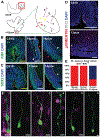Spatiotemporal expansion of primary progenitor zones in the developing human cerebellum
- PMID: 31624095
- PMCID: PMC6897295
- DOI: 10.1126/science.aax7526
Spatiotemporal expansion of primary progenitor zones in the developing human cerebellum
Abstract
We present histological and molecular analyses of the developing human cerebellum from 30 days after conception to 9 months after birth. Differences in developmental patterns between humans and mice include spatiotemporal expansion of both ventricular and rhombic lip primary progenitor zones to include subventricular zones containing basal progenitors. The human rhombic lip persists longer through cerebellar development than in the mouse and undergoes morphological changes to form a progenitor pool in the posterior lobule, which is not seen in other organisms, not even in the nonhuman primate the macaque. Disruptions in human rhombic lip development are associated with posterior cerebellar vermis hypoplasia and Dandy-Walker malformation. The presence of these species-specific neural progenitor populations refines our insight into human cerebellar developmental disorders.
Copyright © 2019 The Authors, some rights reserved; exclusive licensee American Association for the Advancement of Science. No claim to original U.S. Government Works.
Figures






Comment in
-
Evolutionary Expansion of Human Cerebellar Germinal Zones.Trends Neurosci. 2020 Feb;43(2):75-77. doi: 10.1016/j.tins.2019.12.005. Epub 2020 Jan 15. Trends Neurosci. 2020. PMID: 31954525
References
-
- Lange W, Cell number and cell density in the cerebellar cortex of man and some other mammals. Cell Tissue Res 157, 115 (1975). - PubMed
-
- Van Essen DC, Surface-based atlases of cerebellar cortex in the human, macaque, and mouse. Ann N Y Acad Sci 978, 468 (December, 2002). - PubMed
-
- Larsell O. a. J. J., The Comparative Anatomy and Histology of the Cerebellum The Human Cerebellum, Cerebellar Connections and Cerebellar Cortex. University of Minnesota Press; Minneapolis, (1972).
-
- Rakic P, Sidman RL, Histogenesis of cortical layers in human cerebellum, particularly the lamina dissecans. J Comp Neurol 139, 473 (August, 1970). - PubMed
Publication types
MeSH terms
Grants and funding
LinkOut - more resources
Full Text Sources
Other Literature Sources
Medical
Molecular Biology Databases

